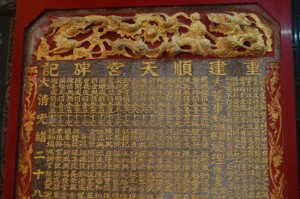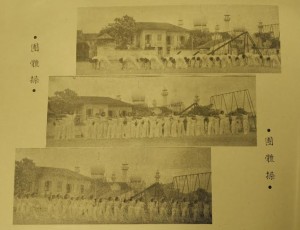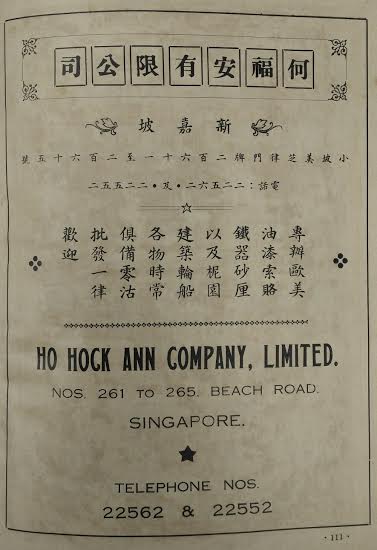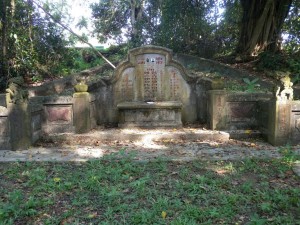An Old Trustee of the Soon Thian Keing
0
He was an old trustee of the Soon Thian Keing (Temple) who together with his wife is buried at Bukit Brown. Through his personal memories, Ho Siew Tien (1864-1960) helped shed light on the temple’s history.
This story by Ang Yik Han begins with the origins of one of the oldest temples in Singapore.
***************************************************************************************
In the 1980s, a debate took place in the local newspapers over the age of an old Chinese temple dedicated to the earth deity Tua Pek Kong in Malabar Street. Historians argued over an ambiguous phrase in one of the temple’s old stelae, which stated that the temple, the Soon Thian Keing (順天宮), was established during the years of the reigns of Jiaqing and Daoguang (“嘉道之際”). As the Jiaqing Emperor ruled from 1796 to 1820 and Daoguang from 1821 to 1850, proponents of an earlier dating for the temple argued that its establishment may have predated the founding of Singapore in 1819. However, there was no direct evidence to support this claim. No artefacts survived from the temple’s earliest days and the stele in question was erected only in 1902 when the temple was reconstructed.

Part of the 1902 stele still preserved in the Soon Thian Keing today. It shows the main temple sponsors and major contributors to the temple’s building fund (photo Yik Han)
One the earliest known accounts of the Soon Thian Keing before its reconstruction was an interview given by one of its trustees, Ho Siew Tian (何秀填), in 1949. He recalled that when he first arrived in Singapore in 1882 at the age of 18, the temple was only a small shrine located next to a tree which housed the Tua Pek Kong statue. The shrine was refurbished by two merchants in 1888. It was only in 1902 (28th year of Guangxu’s reign) that some merchants based in the Sio Po area (the colloquial Chinese term for the part of town north of the Singapore River) came together to construct a proper building for the temple.
Other than getting a new building, the turn of the 20th century was significant for the temple for another reason. Some Hokkien merchants started a school in 1903 and then turned to the temple committee for funding to sustain the school. Thus began the decades long association between the temple and the Chung Cheng School (崇正学校) [not to be confused with Chung Cheng High (中正學校) which was managed by the Hokkien Association].
Every year, the temple provided for the school’s upkeep from the money paid by the resident monk who was contracted to run the temple. In 1916, a school for girls, the Chong Pun Girls School (崇本女校) was started and likewise funded by the temple. Committee members of the Soon Thian Keing sat on the boards of both schools. Prominent alumni members of the Chung Cheng School over the years included Lee Kong Chian and President Ong Teng Cheong.
As the number of students increased, the need for new premises for both schools was keenly felt. In 1938, the construction of a new school building at Aliwal Street was completed. This housed both the Chung Cheng School as well as the Chong Pun Girls School under one roof. It was recorded that Ho Siew Tian was a prime driver in the construction of the new school building along with the then temple chairman. A trustee of the Soon Thian Keing since 1933, he was concurrently the treasurer of the temple and the two schools, a position he held till after the war.
Hailed as one of the most modern Chinese school buildings of its day, the building has been preserved and is today the Aliwal Arts Centre.
As Aw Boon Haw donated substantial funds towards the building’s construction, the school hall was named after his company, Haw Par.
Old photos dating from 1950 which showed girls of Chong Pun exercising in the school field, today a carpark. Sultan Mosque can be seen in the background.
Ho Siew Tian ran a thriving hardware and building materials business under the chop Ho Hock Ann (何福安) at Beach Road. He also owned a number of twakows for transporting goods. As his wealth grew, he made substantial investments in properties. In 1948, he incorporated his firm as a limited company and handed over its running to his sons, who subsequently expanded the business to firearms.
It was urban redevelopment which spelled the end for the temple and the schools. In 1980s, the temple was acquired by the government for building the MRT. It moved successively to various temporary sites before its present building at Lorong 29 Geylang was completed. With the resettlement of the urban residents in the area, dwindling student enrolment led to the closure of Chung Cheng School in the 1980s as well. Its name was transferred to a primary school in Tampines.
Soon Thian Keing today in Lor 29 Geylang (photo Yik Han)
Ho Siew Tian is buried at Hill 4 together with his wife who died 12 years before him. According to obituaries in the Straits Times and the Singapore Free Press, he was one of the oldest men in Singapore at the point of his death at the age of 96. He was survived by 5 sons (2 other sons died before him), 3 daughters, 2 sons-in-law, 7 daughters-in-law, 81 grandchildren, 8 grand sons-in-law, 4 granddaughters-in-law and 37 great grandchildren.









Comments